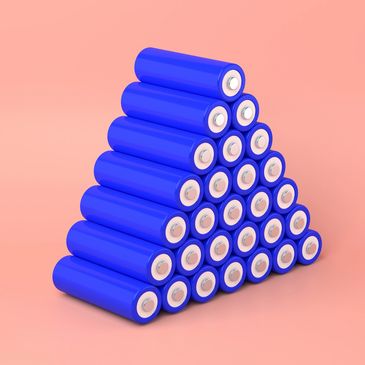Tomorrow’s Batteries, Today’s Innovations

Cylindrical Cell
Cylindrical Cell
Cylindrical Cell
- Structure:
- Shape: Standardized cylindrical form (e.g., 18mm diameter x 65mm length for 18650).
- Layers: Electrodes (anode/cathode) rolled into a "jellyroll" and housed in a stainless steel or aluminum casing.
- Safety: Includes a pressure relief vent to prevent explosions during thermal runaway.
- Key Features:
- Pros:
- Robustness:
- Structure:
- Shape: Standardized cylindrical form (e.g., 18mm diameter x 65mm length for 18650).
- Layers: Electrodes (anode/cathode) rolled into a "jellyroll" and housed in a stainless steel or aluminum casing.
- Safety: Includes a pressure relief vent to prevent explosions during thermal runaway.
- Key Features:
- Pros:
- Robustness: Durable metal casing resists physical damage.
- Thermal Management: Efficient heat dissipation due to cylindrical shape.
- Standardization: Widely produced and interchangeable (e.g., Tesla uses thousands in EV battery packs).
- Cons:
- Space Inefficiency: Gaps between cells reduce pack-level energy density.
- Weight: Metal casing adds bulk.
- Applications:
- Consumer electronics (e.g., laptops, power tools).
- Electric vehicles (e.g., Tesla’s modular battery packs).
- Energy storage systems.

Pouch Cell
Cylindrical Cell
Cylindrical Cell
- Structure:
- Shape: Flexible, lightweight aluminum-laminated polymer pouch (no rigid casing).
- Electrodes: Stacked or folded layers sealed in a foil pouch.
- Weight: Lightest design due to lack of metal casing.
- Key Features:
- Pros:
- High Energy Density: Maximizes space/weight efficiency (no metal casing).
- Flexibility: Can be shaped
- Structure:
- Shape: Flexible, lightweight aluminum-laminated polymer pouch (no rigid casing).
- Electrodes: Stacked or folded layers sealed in a foil pouch.
- Weight: Lightest design due to lack of metal casing.
- Key Features:
- Pros:
- High Energy Density: Maximizes space/weight efficiency (no metal casing).
- Flexibility: Can be shaped to fit unique spaces (e.g., curved devices).
- Low Cost: Simplified manufacturing process.
- Cons:
- Mechanical Vulnerability: Pouch is prone to punctures and swelling.
- Thermal Challenges: Requires external support for heat management.
- Applications:
- Smartphones, tablets, and wearables.
- Electric vehicles (e.g., GM’s Ultium batteries).
- Drones and aerospace systems.

Prismatic Cell
Cylindrical Cell
Lithium ion battery
- Structure:
- Shape: Rectangular or square aluminum or steel casing.
- Electrodes: Flat, stacked layers (not rolled).
- Space Efficiency: Fills rectangular spaces better than cylindrical cells.
- Key Features:
- Pros:
- Compact Design: Higher pack-level energy density due to efficient stacking.
- Customization: Sizes can be tailored
- Structure:
- Shape: Rectangular or square aluminum or steel casing.
- Electrodes: Flat, stacked layers (not rolled).
- Space Efficiency: Fills rectangular spaces better than cylindrical cells.
- Key Features:
- Pros:
- Compact Design: Higher pack-level energy density due to efficient stacking.
- Customization: Sizes can be tailored for specific applications.
- Safety: Hard casing offers moderate protection.
- Cons:
- Swelling Risk: Electrode expansion can deform casing over time.
- Cost: More complex manufacturing than cylindrical cells.
- Applications:
- Electric vehicles (e.g., BMW, Hyundai).
- Industrial energy storage.
- Medical devices.

Lithium ion battery
Chemistries & Applications
Lithium ion battery
- A lithium-ion battery (Li-ion) is a rechargeable energy storage device that uses lithium ions moving between a positive cathode (e.g., lithium cobalt oxide) and a negative anode (typically graphite) to generate electricity. Its high energy density, lightweight design, and long cycle life make it the preferred choice for modern electronics, electric vehicles (EVs), and renewable energy systems.

Key Technical Features
Chemistries & Applications
Chemistries & Applications
- High Energy Density:Stores 150–250 Wh/kg, enabling compact designs for portable devices and longer EV ranges.
- Long Cycle Life:Supports 500–2,000+ charge-discharge cycles (depending on chemistry) while retaining 80% capacity.
- Fast Charging:Reaches 80% charge in 30–60 minutes with advanced charging protocols.
- Low Self-Discharge:Loses only 1–2%
- High Energy Density:Stores 150–250 Wh/kg, enabling compact designs for portable devices and longer EV ranges.
- Long Cycle Life:Supports 500–2,000+ charge-discharge cycles (depending on chemistry) while retaining 80% capacity.
- Fast Charging:Reaches 80% charge in 30–60 minutes with advanced charging protocols.
- Low Self-Discharge:Loses only 1–2% charge per month, ideal for standby applications.
- Lightweight:50–70% lighter than lead-acid batteries with equivalent capacity.

Chemistries & Applications
Chemistries & Applications
Chemistries & Applications
- NMC (LiNiMnCoO₂)Balanced energy/power, moderate costEVs, power tools, e-bikes
- LFP (LiFePO₄)High safety, long lifespanEnergy storage, buses, solar systems
- LCO (LiCoO₂)High energy densitySmartphones, laptops, drones
- NCA (LiNiCoAlO₂)High energy, extreme durabilityPremium EVs, aerospace

Key Innovations
Key Innovations
Key Innovations
- Material Advancements:Incorporated a silicon-graphene composite anode to increase capacity by 30% compared to traditional graphite.
- Structural Improvements:Used a ceramic-coated separator to prevent thermal runaway and enhance safety.
- Sustainability:Cobalt-free cathode chemistry to reduce ethical and environmental concerns.

Applications
Key Innovations
Key Innovations
- Ideal for electric vehicles due to high energy density and fast charging.
- Suitable for renewable energy storage systems requiring long cycle life.
- Optimized for wearable devices needing lightweight, flexible form factors.

Advantages
Key Innovations
Advantages
- 20% higher energy density than commercial NMC batteries.
- 50% lower production cost through simplified manufacturing processes.
- Fully recyclable design, reducing environmental impact.
- Complies with UL 1642, UN 38.3, and IEC 62133 standards.
- Integrated smart BMS (Battery Management System) for voltage/current monitoring.